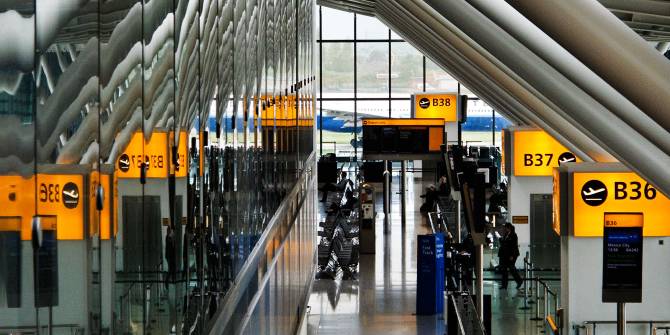The European Central Bank’s PEPP will purchase vast amounts of assets in an effort to support Eurozone economies. John Gordon (LSE) says it should take the opportunity to ‘green’ its balance sheet and avoid investing in polluting industries.
The COVID-19 pandemic has unexpectedly reversed the European Central Bank’s (ECB) policies. While the Bank was planning to slowly phase out its asset purchases, it has now announced a EUR1.35 trillion Pandemic Emergency Purchase Program (PEPP) to support the Eurozone economies.
But one policy it should not reverse is its increasing commitment to fighting climate change. With the crisis, greenhouse gas emissions could drop by up to 7% this year – the same reduction necessary year-on-year if we are to meet the objectives set out in the Paris Agreement. Clearly, this is not a sustainable way to do it. Instead, the ECB should heed calls to ‘build back better’ and use the PEPP to enable the transition towards a green economy.
The ECB has a mandate for green quantitative easing
The debate around ‘Green QE’ isn’t new. Ever since the post-2008 asset purchases, campaigners and politicians have appealed for QE to also fulfil social and environmental goals – particularly through the preferential purchase of green bonds. This has always been met with resistance in Frankfurt. Social and environmental goals are, of course, not part of the ECB’s mandate. For an institution that can only function on trust and credibility, any venture into the political domain is very risky indeed. But last year, things changed. In her confirmation hearing, Christine Lagarde announced she wanted to make climate change “mission-critical”, opening the door to more affirmative policies.
This was not without controversy. Jens Weidmann, the head of the Bundesbank, immediately cautioned the newly-appointed president. He would be reacting “very critically” to any inclusion of climate goals within the ECB’s strategy. Yet, in January, he declared that the ECB should start accounting for “the financial risks that result from climate change”. On the surface, this does not recognise the fight against climate change as an ECB objective. But in substance, it means it could favour green bonds and avoid the most polluting assets, which are highly exposed to environmental risks.
His reversal is not entirely surprising. The financial sector has become increasingly aware of the variety of risks resulting from climate change. These range from the physical risks of a changing environment to transition risks affecting economic activity that could be displaced by a greener economy. The fact that they are not fully accounted for in financial markets can be seen as a market failure. Actively recognising their impact is therefore no longer a controversial or political decision; it aligns with the ECB’s primary objective of price stability. One person’s price distortion is another’s price correction.
Increase the supply of green bonds
An important barrier to a preferential purchase of green bonds is their availability. Although the market was growing healthily at 51% last year, the monthly issuance averaged EUR17.5 billion. Any substantial share of the PEPP’s EUR1.35 trillion would dwarf these amounts. In fact, it could nearly buy up the entire market twice over – and the pandemic hasn’t helped. In March, the issuance totalled a meagre EUR2.5 billion, the lowest volume since December 2015. As French central banker François Villeroy de Galhau pointed out, any substantive intervention could “seriously distort the market”, well beyond any reasonable price correction to account for environmental risks.
It is therefore up to investors, development banks and most importantly governments to push forward the issuance of green bonds. In this, they can build on expanding notions of sustainable finance.

Blue Finance, and the issuance of Blue Bonds, were pioneered in 2018 by the government of Seychelles. These were developed in response to the issue of ‘Ocean risk‘, which emerged in recent years and has given a literal meaning to the idea of stranded assets. The projects that those bonds finance help prepare for future disasters, transition to sustainable economies and boost growth. In a post-COVID world, all these appear indispensable. A striking example is that of blue infrastructure, which integrates nature-based solutions in the multi-trillion infrastructure market: it helps builds coastal resilience, protects the Ocean’s biodiversity and creates jobs. These are the types of projects the PEPP could and should support.
The need for a ‘just transition’ towards a green economy has also led to calls for the issuance of sovereign ‘just transition bonds’. These build on the idea of sustainability bonds and are a mix of social and green bonds. They would not only include green projects but also socially and economically beneficial activities for those displaced by the transition. Although strict guidelines would be needed to prevent greenwashing, this idea has enormous potential to increase the stock of sustainable bonds.
Out with the old, in with the new
The limited availability of sustainable bonds does not mean the ECB should wait for others before it acts. Avoiding the purchase of carbon-intensive bonds would in itself represent progress. On this, the ECB’s actions have been less than laudable. Between March and May, EUR7.6 billion of the EUR30 billion corporate purchases went to fossil fuel companies. This isn’t surprising. In 2017, Sini Matikainen, Emanuele Campiglio and Dimitri Zenghelis showed that ECB asset purchases were skewed towards high-carbon sectors. This is linked to the myth of market neutrality. In short, in trying to avoid any distortion in the price of financial assets, the ECB actually encourages continuity and the persistence of current economic choices. When it comes to the climate crisis, this means supporting rather than displacing the polluting industries which dominate our economy.
This is not to say that the ECB is inactive on the issue. It has launched the second monetary policy strategy review in its 20-year history, which will outline how it can help combat the climate crisis. It has also released a draft proposal on the inclusion of environmental risks and launched a public consultation which is due to end in September. But all of these initiatives may be too little, too late for the PEPP. With a programme of this scale, it is vital that these initiatives are applied to the pandemic response. Wherever possible, the ECB should bring this agenda forward.
In the meantime, greener asset purchases are not the only policy option for central banks to help build back better. In their recent briefing note, Simon Dickau, Nick Robins and Ulrich Volz outline nine possible instruments for a sustainable crisis response from central banks. At the top of the list is a readjustment of collateral frameworks to better account for environmental risks and impose haircuts on heavily exposed assets. Not only would this encourage divestment from high-carbon industries, it could boost the issuance of green bonds. As Kjell Nyborg remarked, “if central bank money is only available against igloos, or igloo-backed securities, igloos will be built” .
There is still time for the ECB to limit its purchase of brown assets and explore the numerous ways to tackle the climate crisis. The PEPP could be a great enabler of the transition towards sustainable economies, but for that to happen the ECB needs to move fast – and do ‘whatever it takes’.
This post represents the views of the author and not those of the COVID-19 blog, nor LSE. It is part of the LSE Maryam Forum, From Rulership to Leadership: Early Lessons from the COVID-19 Pandemic. The author thanks Professor Sam Fankhauser, Torsten Thiele and Dr Simon Dikau for valuable feedback.





